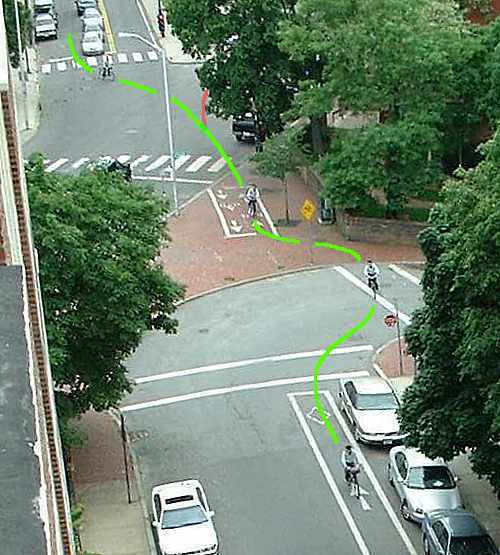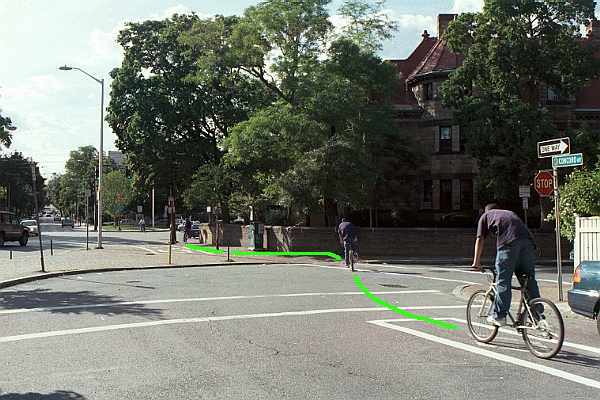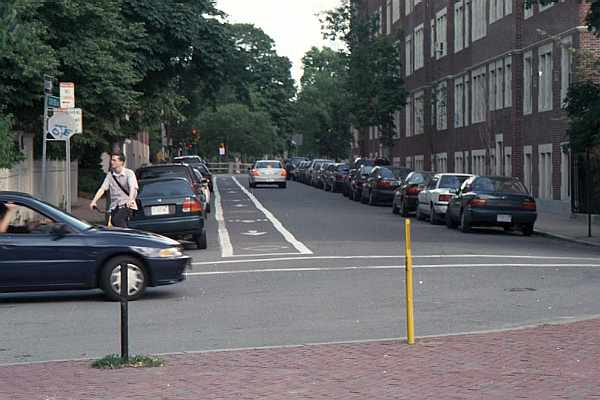 (scroll left to read the text of the Web page) |
Top: Home Page
Up: Cambridge bicycle facilities and program
Previous:
Next:
CONTRAFLOW INSTALLATION,
|
The contraflow bike lane on Little Concord Avenue
(scroll right if necessary to see the rest of the image).
The cyclist in the photo is riding opposite
the intended direction in the lane. Thanks to Niles Management for the
escorted trip to the roof of its building!
 (scroll left to read the text of the Web page) |
The next photo, below, is an enlargement from the left end of the panoramic photo. The path of the cyclist who showed up while I was on the roof is indicated by the green line. An advanced stop line (or "bike box") leading from Garden Street to Little Concord Avenue is intended as part of the route from the Radcliffe campus. The route of cyclists proceeding from the bike box is shown by the red line near the top of the photo. For cyclists headed in the the intended direction in the contraflow lane, there is no traffic signal at Concord Avenue and Garden Street, although the intersection is signalized. Cyclists who wish to continue on Concord Avenue have to guess about when it is safe to cross, or else they must (improbably) operate as pedestrians, crossing to the left side, using the left sidewalk to get to the the next crosswalk, and then crossing back over to the right side to continue riding legally. Cyclists who wish to bear right on Garden Street have it easier -- they only have to merge into the traffic stream, a normal and legal maneuver. |
Path of cyclist across pedestrian plaza and
Follen Street to Little Concord Avenue

In the photo, the cyclist might have merged into line with the waiting cars before the intersection, but instead swerves left in front of a stopped car, without the ability to know when the traffic signal will turn. This choice has everything to do with poor judgment, and nothing to do with the contraflow bike lane except that it is the cyclist's destination. After the cyclist enters the pedestrian plaza, he swerves left; then right, then left again to continue down Little Concord Avenue. The reason for the swerving is clearer in the photo below, another composite image which shows a cyclist traveling in the intended (contraflow) direction. |
Cyclist traveling in intended direction

This cyclist, and several others, were seen to swerve toward the traffic on Follen Street, because the curb cut at the far side in the photo does not line up with the bike lane, or with the bicycle route markings in the pedestrian plaza. Only the bike lane, not Follen Street, has a stop sign. The white picket fence and vegetation on the near right corner in the photo above generate a sight obstruction which add to the hazard of swerving toward Follen Street. The best thing to be said about this situation is that the traffic on Follen Street has to go slowly to make a sharp left turn. Despite the ease of bearing right onto Garden Street, the cyclist in the photo above has decided to continue around a blind corner next to a high wall, on the sidewalk. This sidewalk is also used by bicycle traffic coming in the opposite direction, from the Radcliffe campus.
Another view of the same scene (below) shows a cyclist swerving, more typically, to his right to enter the curb cut, while a car cuts across his path. |
Looking back down the contraflow bike lane from the pedestrian plaza

What should be done here?Along with the bike box on Garden Street and another contraflow lane on Waterhouse Street, this contraflow lane is intended to serve cyclists on an important desire line between the Harvard and Radcliffe campuses. There had been many complaints about cyclists' riding on the narrow paths in the Cambridge Common. The project was an attempt to overcome this problem, and to simplify the Garden Street/Concord Avenue intersection by disconnecting Little Concord Avenue. Unfortunately, the Little Concord Avenue contraflow lane has a number of problems all its own. I have already cited the German example of allowing contraflow bicycle travel on lightly-traveled streets with low speed limits and without bike lanes -- but Cambridge appears intent on installing a bike lane on any and every street that is a designated bicycle route. Better signalization, markings, and placement of curb cuts also could improve the route. A raised crosswalk or speed table might be appropriate to slow the motor traffic. Other issues could be addressed only through cyclist education. No facilities improvement is going to overcome the problem of cyclists who ride into conflict situations and blind spots because they misunderstand how to operate safely. Much of the bicycle traffic on this route consists of students at one of the nation's most prestigious universities, suggesting that there might be a way to reach them with instruction about bicycling, if the university made a commitment to this task. While Little Concord Avenue is on the most direct route between the Harvard and Radcliffe campuses, it does not shorten the trip by much. Cyclists may continue on Waterhouse Street to Garden Street and turn there. A somewhat longer but faster route is to proceeding up Oxford Street from the Harvard campus, then turn left across Massachusetts Avenue (or a similar route for the return trip), completely avoiding the congestion in Harvard Square. |
Top: Home Page
Up: Cambridge bicycle facilities and program
Previous:
Next: